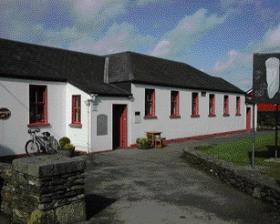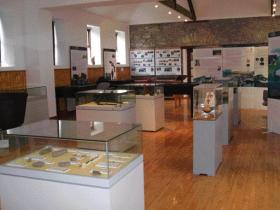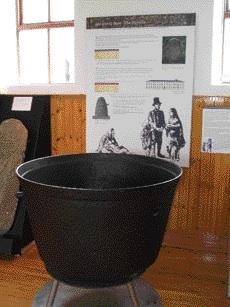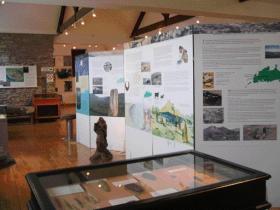Museum Eye: Músaem Chorca Dhuibhne
Published in Issue 6 (Nov/Dec 2006), Reviews, Volume 14
Músaem Chorca Dhuibhne, Baile an Fheirtéaraigh.
Músaem Chorca Dhuibhne
Baile an Fheirtéaraigh, Co. Chiarraí (Ballyferriter, Co. Kerry)
+353 (0)66 9156333/9156100
www.cfcd.ie
10am–6pm daily, April–September
by Tony Canavan
The regional museum for the Corca Dhuibhne Gaeltacht is in the old schoolhouse, built in 1875, in Baile an Fheirtéaraigh. It was opened in 1985 and has been going from strength to strength ever since. I first visited this place about ten years ago and it was very different then. It displayed all the virtues and faults of an amateur local museum. The virtues were the enthusiasm of those involved, the depth of knowledge, the size of the collection and so on. The faults were that the collection was disorganised and driven by a desire to display as much as possible. Cases were crammed with objects and the visitor barely had elbow-room between them.
The museum today is a more professionally run institution and a great example of less being more. The visitor has plenty of room and light to appreciate what is exhibited.

An interactive computer display about ogham stones.
There are plenty of objects on display, but not too many—some cases, in fact, are almost empty, but the permanent exhibition is being revamped and new displays promised. The layout too is quite simple, being in effect one large gallery cleverly divided by information panels that not only separate one section from another but also guide the visitor through the exhibition.
The panels are worth highlighting, as they are state-of-the-art. Alongside the text there are photographs, maps and artists’ impressions of what an archaeological site or medieval castle would have looked like in its heyday. These are all done to the highest standard and are lively enough to keep even a child’s attention. The text itself is worth a special mention as it is bilingual. In most museums, where it occurs, the text in Irish on such panels follows the English and is usually a simple or simplified translation.

Part of the main exhibition space in the museum.
In Músaem Chorca Dhuibhne, as befits the Gaeltacht, the Irish text is the primary one and often carries more information than its counterpart in English. So, for those who have Irish, it is worth reading. In contrast to many other museums, this one also offers guides printed in the main European languages.
Músaem Chorca Dhuibhne follows a definite time line from the Stone Age to the present but wisely does not attempt to create a narrative—that is, there is no ‘story’ of the people of Corca Dhuibhne. The exhibition begins near the entrance with display cabinets on the formation of the landscape, and in particular the geology of the Dingle Peninsula (as it is usually known in English). We then move on to the first human settlement, with a section on the Stone Age featuring both information on archaeological sites in the locality and actual artefacts such as stone querns, bone tools and stone arrows.
By following the panels the visitor is then taken through the various eras of the peninsula’s history, including the conversion to Christianity, the Anglo-Norman conquest, and so on right up to the twenty-first century. The Early Christian period in the region is well represented through a fine collection of ogham stones, crosses and displays on monastic foundations. There are good colour photographs of some important sites in the peninsula, such as the Gallarus oratory and Cathair na bhFionnúrach, an impressive stone fort. A map indicating the location of these places would be useful to the stranger, however. The theme of Christianity is continued with Cósan na Naomh, the Saint’s Path, which is not only a display in the museum but an actual walk that shadows ancient pilgrimage routes. And, of course, no one could discuss Christianity in the area overshadowed by Mount Brandon without reference to St Brendan and his voyage, not to mention Tim Severin’s recreation of it.
The early modern period, which saw the demise of Gaelic rule, is well covered. It relates the story of the massacre by the English at Dún an Óir in 1580 of Continental soldiers who arrived to help in the Desmond Rebellion, and also of Spanish Armada wrecks off the coast.

Famine soup pot.
How Dún an Óir, the Fort of Gold, got its name is explained in the fascinating tale of Fool’s Gold brought back from the Arctic by the English explorer Frobisher. Samples of these glittering rocks are in one of the display cabinets.
More recent periods in history are covered by displays on local industry and farming as well as on the Great Famine. This includes a huge ‘Famine pot’ that was used to make soup to feed the starving. Such pots were common in areas hard hit by the Famine and gave rise to the term ‘souperism’, we are told, because of the belief that people had to convert to the Protestant faith in order to be given soup.
At the other end of the scale is a display on ‘Hollywood’ in the area, featuring films that were shot here, such as Ryan’s Daughter. As well as photographs, including an autographed one of Tom Cruise, there are items relating to the making of films, for example the shooting script from Ryan’s Daughter.

Some of the prehistoric exhibits.
Unusual objects worth mentioning are an 1888 British Army bayonet that was used by Pádraig Búlaer, captain of the Irish Volunteers in Ballyferriter in 1916. Nearby is a cabinet containing the medals of a remarkable early twentieth-century local sportsman, W. O’Connor, who excelled in hockey, boxing and tug-of-war, among other things. The museum also makes good use of models, such as that of the local currach, or naomhóg, and the locomotive of the famous Tralee and Dingle light railway. There are also two computers featuring interactive programmes to add a further dimension to the visitor’s experience. The computers are situated in an area hosting a temporary exhibition of wildlife photography. This is excellent, although a new permanent exhibition on the subject is promised. As you leave the gallery you pass a panel dedicated to the Irish-American Dunfey family, who are patrons of the museum and without whom it could not have opened.
You can finish off your visit by dropping into the museum’s café, which also includes a shop selling books for all ages in Irish and English about the area and Ireland in general. After that journey through thousands of years of local history you may be glad of a cup of tea and a home-baked scone.
Tony Canavan is a former Museum Officer of Newry and Mourne District Council.
















